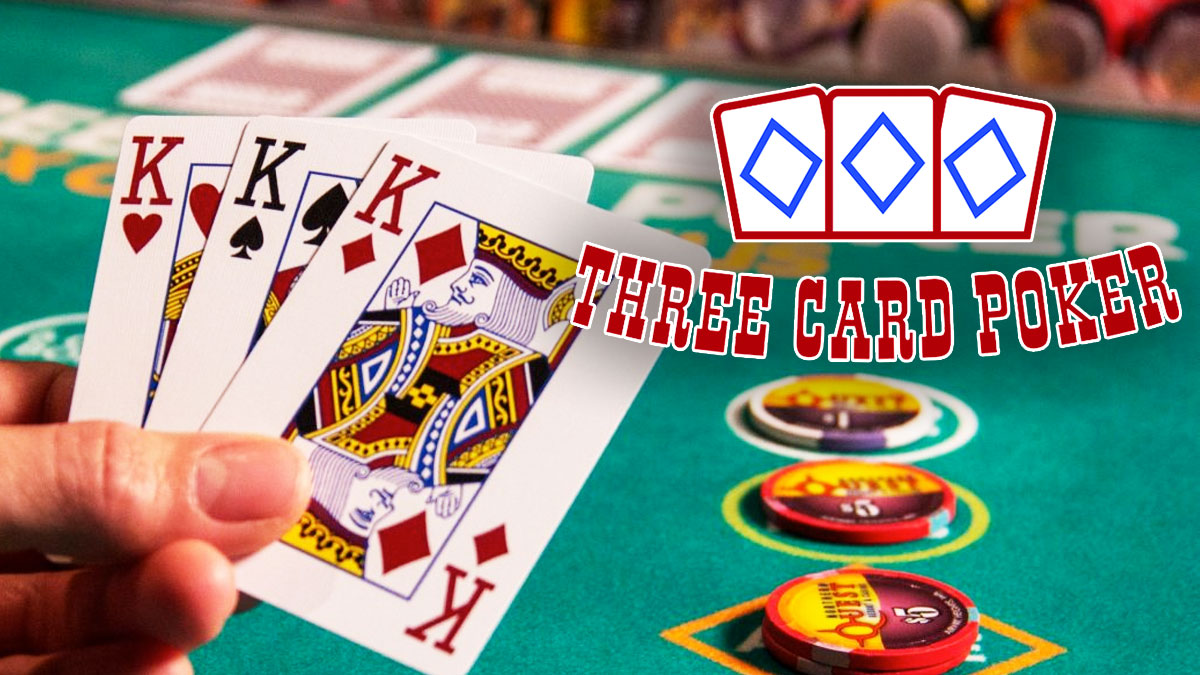The year was 1997 and, to that point anyway, casino table game players who preferred playing cards over dice and wheels had just two options available—blackjack and baccarat. Of course, they could always tangle with the cardsharps in the poker room playing Texas holdem or Seven-Card Stud, but traditional poker is far from a table game.
Then came Derek Webb and the seamless integration he dubbed “Three-Card Poker.” Webb debuted his innovative gambling invention in a small Mississippi riverboat casino, and as they say, the rest was history.
1 – A High House Edge on the Ante Bet
Before going any further into why casinos love players who prefer Three-Card Poker, let’s run through a quick crash course on how to play the game.
After placing a mandatory ante bet to get started, Three-Card Poker proceeds with a simple and straightforward deal. Let’s say that most recreational gamblers start out with $5. You’ll get three cards face up while the dealer gets three cards face down.
Despite the poker connotations, you can’t discard any of your hole cards, nor can you draw any additional cards to improve. What you see is what you get.
And using a modified three-card hand poker ranking hierarchy, the best possible hand is a royal flush (A-K-Q of the same suit), followed by a straight flush (any three-card string of the same suit), three of a kind, a straight, a flush, one pair, and high card.
Once you’ve sized up your three-card hand’s relative value, you get a single player decision point to work with — fold or play. Folding obviously ends the hand immediately, and you surrender your ante bet without further trouble.
By placing the play bet, however, you must match your ante bet to continue onward to a showdown against the dealer. Beat a “qualified” dealer hand of queen-high or better, and you’ll win even money on both bets. Besting an “unqualified” dealer hand pays back even money on just the ante wager while the play bet is deemed a push.
Finally, when you’re lucky enough to land the strongest hands, an “Ante Bonus” pay table awards payouts of up to 5 to 1 to sweeten the pot.
Using this elegantly simple construction, Webb created one of the catchiest table game additions that you can play when gambling in a casino.
Add it all up and Three-Card Poker offers the player a house edge of 3.37% when the most common Ante Bonus pay table is in play.
And therein lies the rub when it comes to Three-Card Poker.
Speaking to SF Gate in 2009, Webb explained his overarching motivations as an aspiring table game designer back in the mid-‘90s:
“You have to be able to talk on one level to the management about why the game will generate more revenue than some of the existing games that they’ve got.
Saying to a manager ‘My game is a great game’ is meaningless, because they hear that 10 times a month.”
While he would never come right out and say it, Webb’s reference to “generating revenue” for the casino is quite telling. By carefully constructing the win probabilities of Three-Card Poker and calibrating them against the Ante Bonus pay table, Webb ensured the house an inherent edge of well over 3%.
By comparison, the classic card game of blackjack affords sharp players a house edge of only 0.50%. Play real money baccarat and you’ll be up against house edge rates of 1.06% (banker bet) or 1.24% (player bet). And even on a pure game of chance like single-zero roulette, the house’s edge only climbs to 2.70%.
Clearly then, Webb sought to create a game that casinos couldn’t resist. By ramping up the house edge into the mid-3% range, he gave pit bosses every incentive to swap out a few struggling tables to give Three-Card Poker a fair shake.
Thus, it was no surprise to see the game’s initial table installation in Mississippi expand like wildfire. Within a year, the game had staked its claim across dozens of Sin City casinos before eventually peaking at about 2,000 installations nationwide.
During the game’s heyday, table game gamblers could be forgiven for having a little fun on a higher house edge offering. After all, the pit wasn’t exactly brimming with options back then.
But in 2021, with so many alternative table games out there—not to mention resources for savvy players like this very site—Three-Card Poker’s shine has dulled considerably.
Other poker-based table games such as Pai Gow (1.50% house edge), Ultimate Texas Hold’em (2.19%), Heads Up Hold’em (2.36%), and Double Down Stud (2.67%) all offer significantly better odds from the bettor’s perspective.
And remember, that 3.37% house edge assigned to Three-Card Poker only covers the ante and/or play bets.
2 – “Mini-Royal” or “Six-Card Royal” Bets Are for Suckers
Every table running Three-Card Poker offers a supplementary wager which, unlike most side bets, almost seems like a standard part of the game.
In this case, the optional pair plus bet gives players a chance to turn their strongest hands into premium payouts. For example, a pair plus bet followed by a straight flush brings back a whopping 40 to 1 payout. Three of a kind will get you 30 to 1 on your money, followed by 6 to 1 for a straight, 3 to 1 for a flush, and even money on any one pair hand.
In a 2017 interview with Roger Gros of Global Gaming Business magazine, Webb explained why he made the pair plus bet such an integral part of Three-Card Poker (emphasis added):
“I wanted to design a three-unit bet game that incorporated what I thought was the best of Caribbean Stud and the best of Let It Ride, and it was going to be naturally faster.
But also, the design needed to make sure that we got the three bet units out more frequently than Caribbean or Let It Ride.
And those two combined features meant that it could go with a lower house advantage than either of those games, and give the player a more positive experience, and at the same time, create a higher win for the operator.”
Thanks to the table’s inconspicuous felt layout design, most players who sidle up to a Three-Card Poker Table simply believe the pair plus bet is part of the base game.
And for good reason, as Webb alludes to in the quote above…
With a severely steep house edge of 7.28%, the bet ranks amongst the worst wagers found in any table game pit. In fact, it’s only slightly better than Triple-Zero Roulette (7.69%)—only one of the most hated adaptations made to casino games in the last 50 years.
Webb’s intention to design an appealing “three-unit” game which benefits the house is understandable. With that said, Three-Card Poker doubles down by offering a pair of longshot side bets which verge on absurdity.
Many casinos offer a progressive jackpot program on the game which pays out five- or six-figures when you land a three-card royal flush. Stories circulate about these rare hits, but based on the odds, you’ll only see a three-card royal arrive once in every 22,100 hands.
Even worse, casinos regularly tout their “instant millionaires” who cashed in on the progressive “six-card royal” (9-10-J-Q-K-A suited) jackpot. But for every winner, more than 5 million bets were placed and lost on average in futile pursuit of the ultimate longshot.
3 – Players Have Much More to Lose on Every Hand
Webb’s desire for a three-unit table game experience matched that of house, because more money on the table means more money sent to the casino’s coffers.
This is due to a gambling probability metric known as the “element of risk.” Whenever games offer players multiple betting points within a single hand, these games incur a different element of risk than binary “bet / settle” games.
And in Three-Card Poker, the element of risk stands at 2.01% or nearly four times that found in Ultimate Texas Hold’em (0.53%). Blackjack under Atlantic City rules can be played with only a 0.38% element of risk, while Heads Up Hold’em (0.64%) and Crazy 4 Poker (1.09%) are both much better options.
Just remember, if you’re a basic $5 or $10 bettor at the blackjack table, you’ll need $15 or $30 to cover your expenses at the Three-Card Poker table.
Conclusion
When he first unleashed Three-Card Poker upon the gambling masses, Webb was revered by players and operator’s alike for devising the “perfect” casino game. And indeed, it only takes a few dances with the dealer to discover the natural hook Three-Card Poker creates.
It’s fun, it’s easy to play, and it doesn’t involve any strategy other than the simple “Queen-6-4” threshold for folding or playing. Throw in jackpot payouts along with several escalating pay tables for premium hands, and Webb’s genius is undeniable.
Unfortunately, he decided to use those powers to benefit the house at every turn, producing a high house edge and several sucker bets in a conveniently accessible package.
Michael Stevens
Michael Stevens has been researching and writing topics involving the gambling industry for well over a decade now and is considered an expert on all things casino and sports betting. Michael has been writing for GamblingSites.org since early 2016. …



